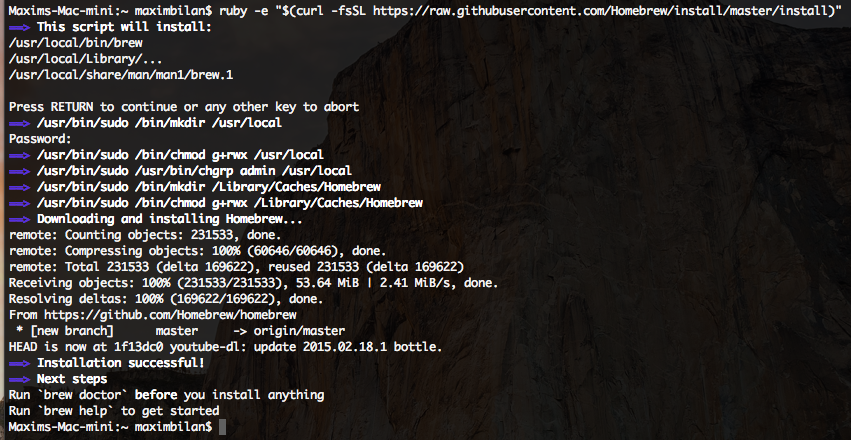- 2Methods for Creating a Movie from an Image Sequence
About
The DICOM Image file type, file format description, and Mac, Windows, and Linux programs listed on this page have been individually researched and verified by the FileInfo team. We strive for 100% accuracy and only publish information about file formats that we have tested and validated. ImageMagick utilizes multiple computational threads to increase performance and can read, process, or write mega-, giga-, or tera-pixel image sizes. The current release is ImageMagick 7.0.11-6. It runs on Linux, Windows, Mac Os X, iOS, Android OS, and others. The authoritative ImageMagick web site is https://imagemagick.org. ImageMagick is an open source image processing software suite that comes in handy to anyone that needs to compose, edit, create and convert bitmap images. Powerful command-line based Image editor. ImageMagick installer for Mac OS X. Cactuslab provides this installer package to simplify the process of installing ImageMagick on Mac OS. ImageMagick installer for Mac OS X. The installer puts ImageMagick into /opt/ImageMagick and adds it to your PATH by creating an entry in /etc/paths.d/. These ImageMagick installers include the following delegates: bzlib fftw jng jpeg lcms lzma png ps tiff xml.
On this page I've listed a few options which can help you take a sequence of numbered image files, each representing a 'frame', and convert that into a movie file.
NOTE: In all cases, it's pretty much assumed that your image sequence is put in its own separate folder and the image names should be end with numbers as per the examples below:
- 'frame000.png', 'frame001.png', 'frame002.png', etc
- 'my_movie_001.jpg', 'my_movie_002.png', 'my_movie_003.png', etc
Methods for Creating a Movie from an Image Sequence
Option 1: QuickTime Pro...... ($30 for Mac and Window)
QuickTime 7 works on Windows and Mac (not Unix) and it costs ~$30 to unlock the 'Pro' version which can be used to modify movies. Instructions to install QuickTimePro are here. Once installed you must make sure you have a sequence of (same sized) images in a numbered sequence (eg: img000.tif, img002.tif, ... img099.tif). Within QuickTime click: File > Open Image Sequence and select the first one. From here you can chose frame rate and it will save to a huge .mov file, but after saved you can go File > Export to save to a number of different compressed formats. Read more about these export options [[[QuickTime|here]]. Even though it costs $30, this is my preferred choice for because I like having lots of export options.
Option 2: ImageJ...... (free and cross-platform)
ImageJ uses Java so is cross platform (Windows, Mac OSX and Unix). ImageJ/'Fiji' (a fuller featured version) can reads and writes many image formats, but only writes out one type of movie format - and that is AVI. Often AVI is all you'll want though (especially if you want a PowerPoint movie) and the instructions are as follows:
- Copy all the images/frames you want in a single directory with nothing else, and make sure they are in alphabetical order. For example: 'frame000.jpg', 'frame001.jpg', etc.
- Open ImageJ.
- Click File > Import > Image Sequence, navigate to the desired directory and click Select. There are some nice options here for scaling etc.
- Click File > Save As > AVI..., select your frames per second (25 is good if you have many frames) and save you AVI.
There are no options for AVI quality, but this is still very effective if you happen to have ImageJ/Fiji installed.
Option 3: VirtualDub...... (free, but Windows only)
VirtualDub is for Windows only and was designed for creating and editing AVI files. Once you've installed the program from here, just do the following:

- Open VirtualDub then click File > Open, then select the first image in the sequence.
- Click Video > Frame Rate, to change the frame rate (once loaded).
- Click File > Save as AVI to save.
Option 4: ImageMagick.... (free, command line and cross-platform)
ImageMagick is a free command line program which works in a Unix Shell, so can be used via Mac OS X's Terminal program, but can also be run on Windows via a separate executable. It reads in hundreds of type of image formats, but only writes out MPEG or animated GIF. It is also tricky to get conversions to work, so if you're not comfortable or unfamiliar with command lines I suggest you skip this option! To install ImageMagick go to the imagemagick download page. If using a Mac, the easiest way to install ImageMagick is to install 'MacPorts', then run 'sudo port install ImageMagick'. For Unix, ImageMagick may already be installed, and you can type 'convert' into the command line to check. Once installed, you should put all your frames into a separate directory, restart a new shell and then run this command:
Actually I've never had this work for me, because ImageMagick has many nasty dependencies. If that doesn't work the following line creates an animated GIF (yuck):
NOTE: A similar command line toolset you can install is FFmpeg
Option 5: Adobe Photoshop.... (costly, Windows and Mac)
Imagemagick Mac M1
Although expensive, Adobe Photoshop is a program many people may have already.
From CS3, Photoshop allows you to create movies/animations. Prior to that ImageReady was used for this.
For CC and later see: https://helpx.adobe.com/photoshop/how-to/make-animated-gif.html
For CS3 to CC use:
- Go: File > Scripts > Load Files into Stacks... (This option will add all your image in as one file with separate layers) and add all the images you want in the animation.
- Open the Animation Palette under: Window > Animation.
- Click on the Flyout Menu on top right corner of the animation window and select Make Frames from Layers.
NOTE: If your frames are backwards click the bottom left icon to of the animation window get into 'frame animation mode', select all the square frames then click the flyout again and reverse frames. - Adjust the timing of each frame by selecting the 0 sec. on the frame.
- Go: File > Export > Render Video. Among the many options you can save as a movie for Flv, IPhone, IPod, Quick Time, MPEG4 and so on. I recommend using compression type 'H.264'.
Links
- Creating Animations for Presentations and the Web - a great article by Jens Nockel's which helped me write this wiki page.


File TypeDICOM Image File
| Developer | NEMA |
| Popularity | |
| Category | Raster Image Files |
| Format | Binary |
What is a DICOM file?
A DICOM file is an image saved in the Digital Imaging and Communications in Medicine (DICOM) format. It contains an image from a medical scan, such as an ultrasound or MRI. DICOM files may also include identification data for patients to link the image to a specific individual.
The DICOM format was developed by the National Electrical Manufacturers Association (NEMA). It was designed to exchange and view medical images, such as CT scans, MRIs, and ultrasound images.
Imagemagick Mac Brew
The initial DICOM standard was initially released in 1983 and went through various revisions in the 1990s and 2000s. NEMA still actively maintains the format.
NOTE: DICOM images more commonly use the .DCM extension.
How do I open a DICOM file?
You can open DICOM files with various applications, such as MicroDicom viewer (Windows), ezDICOM (Windows), OsiriX (macOS), and MeVisLab (multiplatform). You can also upload DCM files to View My Scans and Jack Imaging in a web browser and view the images.
Open and view .DICOM files with File Viewer Plus.Programs that open DICOM files

Imagemagick Mac
